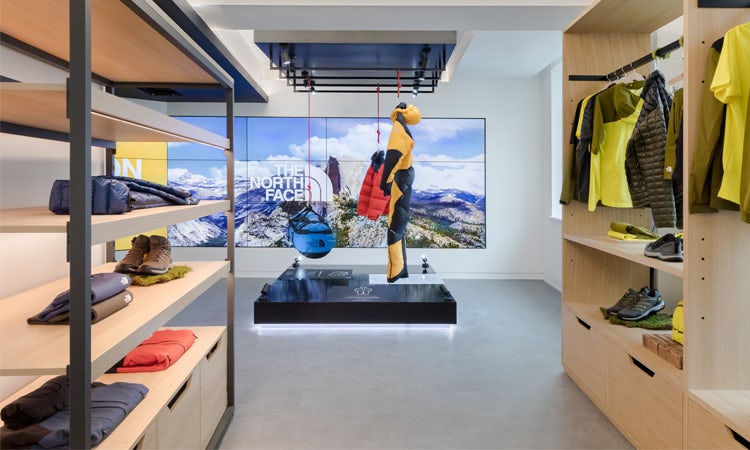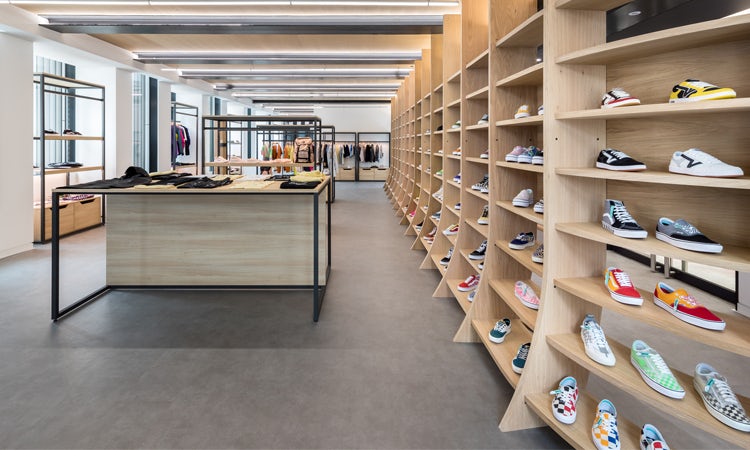How this 120-year-old apparel giant is trying to reinvent retail
From augmented reality mannequins to ultra-customisation, the parent company of Vans and Timberland wants to prove big corporations can embrace change fast and stay relevant in a volatile retail landscape.

VF, the owner of iconic brands including The North Face, Vans and Timberland, is entering another period of big transformation as it looks to lead the charge through purpose-led design and sustainable innovation.
The manifestation of this can be seen in its new Axtell Soho retail space in London, which opened earlier this month to showcase how VF is using technology to reinvent its portfolio and bring the stories of its brands to life in new and immersive ways.
From Timberland’s relationship with its suppliers and factory craftsmen and North Face’s new nanospinning technology, to how Vans’ customisation requests influence future product trends, the six-story, digitally connected building features custom video walls and cinema surround-sound to immerse customers in each of VF’s brands
Meanwhile, avatar-based virtual mannequins showcase key seasonal looks in 3D and users can use the touchscreen displays to change the lighting and visualise the products in different scenarios.
“The big opportunity we have [with Atxell Soho] is how do we focus in creating more dynamic, relevant, contextual experiences for our consumers and how do we do that in a much more unified way,” VF’s chief digital officer, Velia Carboni, tells Marketing Week.
“It doesn’t matter if you walk into a store or go online, we know who you are as a consumer and we can best service you for the needs you have expressed or what we anticipate you may have a need for. Our focus is about being consumer focused and leveraging technology to make that easier.”
We have to balance what this company was with what we want this company to evolve to be.
Velia Carboni, VF
While Axtell Soho is not open to the public – it will initially be used as a “showcase” for business partners – VF will be using the space as a test and learn environment for stores and seeing how it can enhance the customer experience.
“This industry needs to get out of the mode of that one-time transaction; it really is about building that loyalty, that engagement with our consumers, back to the brand and the purpose that these brands bring to life,” Carboni adds.
“[Axtell House] starts to represent that storytelling our brands have and the extension of this will be into more consumer-facing stores or online. We’re going to get more into this test and learn and see what works and what resonates and what really helps draw people into what that brand means and not the actual products. It’s so much more than products, it’s about being part of something.”

This is why VF is looking to involve the consumer much sooner in the design process and product creation phase. This might be through having conversations with designers or using online tools to virtually co-create with consumers.
“You’re going to see a lot more shift of that happening earlier in the process so we’re not just building because in the brands at VF we think it’s the right thing, it’s how do you bring that consumer-centricity all the way to product creation?,” Carboni explains. “That’s where technology allows us to do that at scale.”
But for a company as big as VF, which makes around 500 million products every year, has 55,000 employees worldwide and revenue closing in on $14bn in 2019, Carboni says it is crucial to be willing to iterate as you go and not fall into the trap of wanting to try everything.
Boots aims to ‘reinvent’ retail experience with dramatic beauty overhaul
“Things are moving very quickly and we have to stay focused on the things that are most important to drive the consumer and brand experiences we want,” she says. “Sometimes our appetites become big, meaning we want to try a little bit of everything. We have to balance what this company was with what we want this company to evolve to be.”
‘Incubator’ brands and ‘dangerous’ digital
Vans, The North Face and Timberland bring in the big bucks at 120-year-old VF. But its smaller brands – some of which include Kipling, Dickies, Eastpak, Napapijri, Icebreaker, Smartwool and Altra – play an equally important role in its reinvention.
In fact, whether it’s a new media vehicle, new customer or new way of going to market, VF makes the most risky bets with its smaller brands.
“We use the word incubator, which is where our small brands can sometimes take big risks that our big brands sometimes cannot take,” explains VF’s vice-president of strategy, Jan Van Mossevelde.
“And sometimes it will be the big brand that makes the biggest risk because big dogs, big puppies. If you make big bets, you tend to get big rewards. It can also sometimes fail but that’s part of the experience.
I’d rather not make the sale right now but make that long-term investment with you as a consumer.
Velia Carboni, VF
“The most risky bets we will make with our much smaller brands. But on the other hand it’s act fast, fail fast, learn fast. So we can replicate and always increase the scale and impact by leveraging it and expanding it into the portfolio. But never the exact execution, more of the principle.”
VF is increasingly shaping its organisations to match a world where consumers are always-on but not always looking to buy, which is why Van Mossevelde believes digital is a “dangerous” word.
On the one hand, it is a channel where people spend money and buy, he says. On the other, it is simply the next stop in a journey of how people consume content.

“When we were watching TV or newspapers no one was worried about, can I click my newspaper article or touch my button on my TV and buy? It was a vehicle to communicate to the consumer,” Van Mossevelde explains.
“The goal of marketing has always been to go where your target group is to tell your message. If today our consumers are no longer watching TV and spending all their free time in digital environments, we need to be there with our message. That doesn’t mean we need to be there with a ‘buy me now’ because we weren’t doing that when it was a print newspaper or TV 30-second ad.”
“That’s the mental shift we have to make,” Carboni concludes. “Digital marketing for a long time really became about pushing that one-time sale and that model has significantly shifted because our consumers want it to shift and we as a company want it to shift.
“I’d rather not make the sale right now but make that long-term investment with you as a consumer and know we’re going to have more of a relationship over time. Sales will come from that.”






